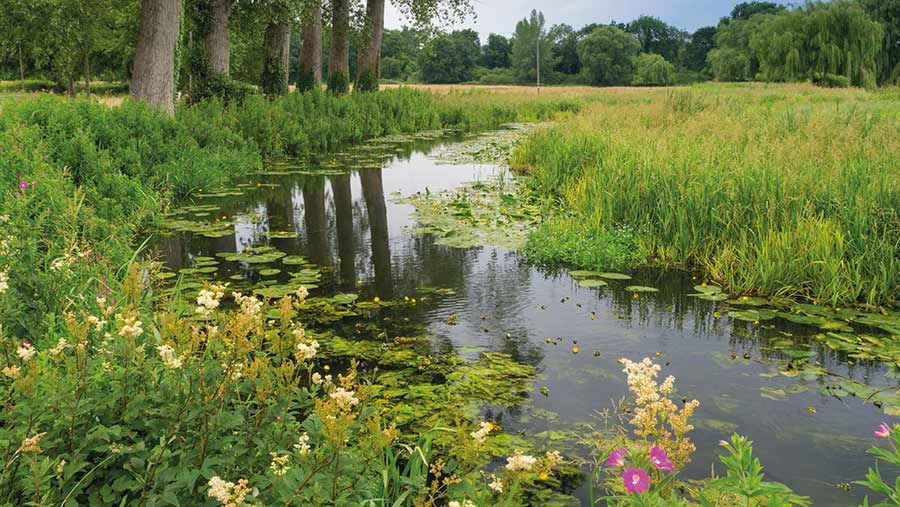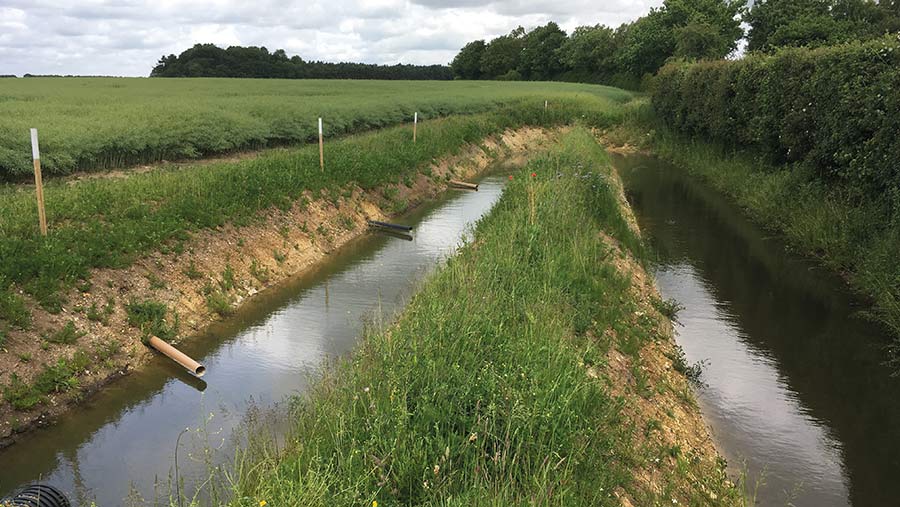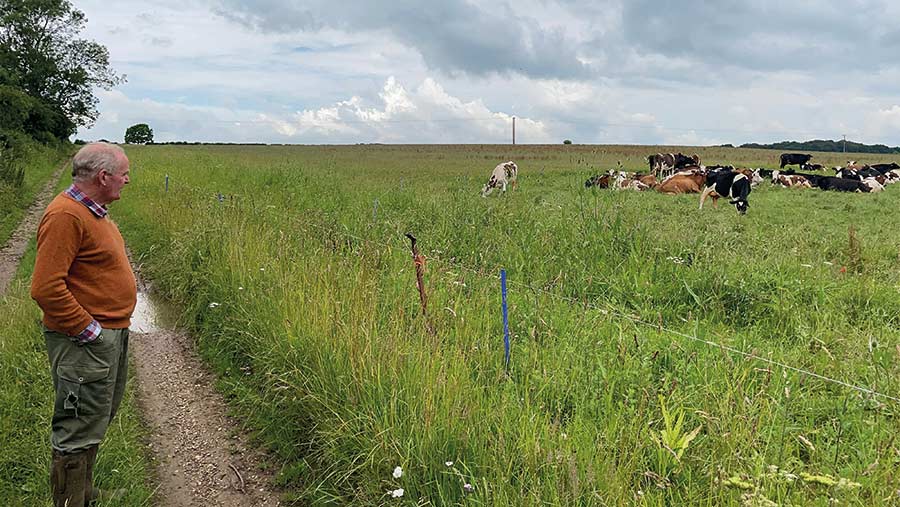What farmers can do to unlock the value of natural capital
 The River Wensum in Norfolk © Loop Images Ltd/Alamy Stock Photo
The River Wensum in Norfolk © Loop Images Ltd/Alamy Stock Photo Natural capital is the cornerstone of agricultural policy across the UK. The term encompasses all of nature’s assets: soil, air and water and every living thing, including trees and woodland.
A well-managed landscape has benefits for people and the economy. Put simply, the vital services that come from natural capital – such as pollination, flood control, clean air and fresh water – make life possible for people.
See also: Why a climate-positive farm shows value of natural capital
Often overlooked, these ecosystem services have an obvious value – and not just environmentally.
Value of natural capital
The World Economic Forum estimates that more than half of global GDP is dependent on nature.
Although the four UK nations each have their own agricultural policies, farm support across Great Britain and Northern Ireland is increasingly based on the concept of natural capital – rewarding farmers who deliver environmental outcomes.
This broad policy of “public money for public goods” recognises the role farmers and other land managers have in mitigating climate change, reversing biodiversity loss, improving soil health and providing cleaner air and water.
Big business is also adopting a natural capital approach.
Some water companies pay farmers not to spread fertiliser near watercourses. Farmers can also earn money by creating habitats to offset the biodiversity loss caused by building developments.
Natural capital – easy wins
- Improve hedgerows and create new ones
- Switch to a 100% renewable energy provider
- Create new carbon sinks by planting woodland areas
- Introduce measurable environmental goals
- Monitor soil organic matter levels and work to increase them
- Use green manures, buffer strips and cover crops
- Reduce soil disturbance
- Protect watercourses and reduce flood risk
- Consider providing recreational access
Two elements to natural capital
For farmers, it is important to realise there are two elements to natural capital.
Savills’ head of natural capital, Jon Dearsley, likens the stock of on-farm natural capital to a balance sheet. The ecosystem services it provides is the profit-and-loss account, he says.
“On one hand, you have the hedgerows, trees, soil and biodiversity on your farm, which is your natural capital stock.
“Then you have the ecosystem services, or operational bit, such as carbon sequestration, which that stock can provide.”
How farmers can benefit
Demand is likely to increase for ecosystem services, which create social, environmental and economic benefits.
Previously provided “free” by nature, many have a financial value and are no longer taken for granted.
“The natural capital market is still in its infancy but it is the mechanism for how growers will be rewarded for looking after existing environmental features and introducing new ones on the farm,” says Mr Dearsley.
Agri-environment schemes, such as Countryside Stewardship, already do this.
Bigger rewards are coming for environmental and recreational benefits as new schemes are rolled out and privately funded initiatives get under way.
To start taking a natural capital approach – which often involves a change in management – farmers should have clear business goals and make an inventory of the natural capital assets on their own farm at the moment.
“A baseline study gives you that information,” explains Mr Dearsley. “Once you’ve done that, you can think about long-term budgets and investments, such as solar panels, as well as how you are going to achieve your aims.”
Natural capital on most farms falls into one of five key categories
1. Soil
A Soil Carbon Code may still be a long way off but there’s every good reason to look after your soils and increase their organic matter content, as well as limit compaction and erosion.
“You may not be paid to do that at the moment, but it already makes good business sense to protect and improve your soil,” says Mr Dearsley.
Soils play a central role in nutrient cycling, carbon storage, water quality and flood prevention – all things that could attract financial support in the future but are also important for profitable food production now.
“With soil, it’s about getting your house in order, reducing your liabilities and improving resilience,” he says. “We know that arable and grassland soil options will be available under the SFI, so there’s no time to lose.”

A silt trap on the Salle Estate © Norfolk Rivers Trust
2. Water
Water quality can be adversely affected by the run-off of fertilisers and slurries from farmland, as well as through erosion – with both sediment and excess nutrients being detrimental.
Land management practices such as buffer strips, margins and cover crops can help by reducing run-off and preventing pollution, as well as limiting nutrient losses to water.
“This sort of good-practice action has attracted financial support for some time in existing agri-environment schemes,” says Mr Dearsley.
“On the catchment scale, water companies have been working with groups of farmers for a while, incentivising them to move to ferric phosphate for slug control, for example, or adopt a change in farming practices.”
Flood risk management is another area where a well-managed landscape can help.
This includes the creation of wetlands and slow-the-flow features such as leaky dams and strategically planted riverbanks to reduce flooding.
Producing clean water: Water Sensitive Farming
Water Sensitive Farming is a collaborative initiative delivering the support and advice for on-farm measures that improve the quality and resilience of the surrounding water environment.
Funded by a partnership between WWF and Coca-Cola since 2012, and latterly involving Tesco, the initiative operates at a catchment scale and develops bespoke and flexible solutions tailored to individual farms.
To date, some 220 farmers have received individual advice and follow-up visits, with more than 2,770ha of land use improvements delivered.
More than 2.15bn litres of water have been returned to the environment already.
The scheme supports nature and farming by encouraging changes in farming practice.
This includes from the adoption of cover crops and buffer strips through to “slow-the-flow” type interventions, such as silt traps.
A voluntary scheme – with no obligation for farmers to engage – it provides advice free of charge across four management catchments in East Anglia, including the River Wensum in Norfolk.
3. Air
Agriculture is responsible for some 10% of UK greenhouse gas emissions.
But farmland and woodland can also contribute to the provision of cleaner air by removing pollutants from the atmosphere.
In terms of emissions, the main challenges are methane from livestock and nitrous oxide from nitrogen fertiliser.
Carbon dioxide and other forms of pollution from combustion-driven machinery also contribute.
Taking steps to improve slurry storage, incorporate manures and increase the accuracy of nitrogen fertiliser applications can help reduce emissions, as can better diet management and improved housing of livestock.
Other areas to look at include alternative energy sources to replace fossil fuels, suggests Mr Dearsley, as well as measures to improve productivity.
“As with soil, there are good business reasons to adopt these measures, rather than any immediate payments on offer, although there will be help with improving slurry storage when the government’s Slurry Investment Scheme opens later this year.”
4. Farmland trees
Woodland and tree planting is a means of mitigating climate change and reversing biodiversity loss, as well as help farming meet its net zero ambitions.
Incentives for woodland creation and management of existing woodlands come in three possible revenue streams – government support, carbon payments and private finance – with all of them already available to farmers.
The Woodland Carbon Code is a good scheme with an established reputation, says Mr Dearsley. It allows farmers and land managers to generate and sell independently verified carbon credits.
The Woodland Carbon Guarantee is less attractive, he believes, especially as private deals are on offer.
Another government scheme, the England Woodland Creation Offer, supports the creation of woodland and its ongoing maintenance for a period of 10 years. It can be used to support smaller areas of woodland.
5. Biodiversity
Putting an economic value on biodiversity is complex and difficult. This is one reason why Defra assesses farmland habitats and gives them a comparative value.
For most farmers, having a plan of what they want to happen on the farm will allow them to make the most of any appropriate features and the opportunities they present for building biodiversity.
These include wet corners and inaccessible areas of the farm.
“Once that’s been achieved, you can have a management plan to achieve it, even if it’s not yet clear as to who is going to benefit and what it’s worth,” says Mr Dearsley
Land situated on the edge of a town or city may provide an opportunity to sell biodiversity credits to a developer, says Mr Dearsley.
“Biodiversity net gain allows developers to offset any loss in biodiversity caused by their activities. For some farm businesses, this is a good opportunity, although it must be recognised that these are long-term land use change agreements.”
Natural capital: What’s it worth on farm?
A natural capital account, prepared for an organic 1,000ha farming estate on the Hampshire/Wiltshire border, shows that the economic value of the public goods that will be generated by the farm over the next 60 years will be a staggering £125m.
The stock of assets on the mixed Cholderton Estate generates a range of benefits that are considered to have an economic value, so Defra figures were used to produce a Natural Capital Balance Sheet.
It takes a long-term look over 60 years.

Owner Henry Edmunds on the Cholderton Estate © Henry Edmunds
The gross asset value of production is projected to be £18.5m, including £5.4m of food production.
The public goods that the farm is generating are valued at £125m after accounting for £5.8m lost through ammonia emissions from livestock.
The estate has a balanced system of farming with nature – with a healthy soil at its heart. Dairy, beef and lamb enterprises help Cholderton build natural fertility in the soils, pull carbon out of the atmosphere and store it in the ground.
There is also a wide range of wildflowers, grasses, insects, birds and mammals on the estate.
This includes some 70 different plant species, 40 species of butterflies and 740 species of moths being recorded.
